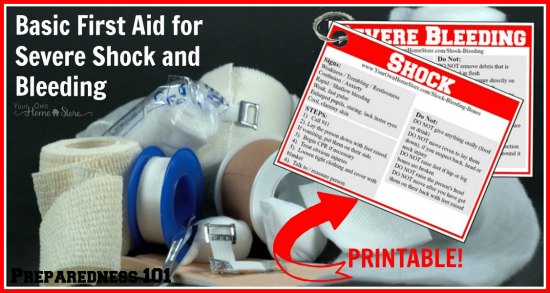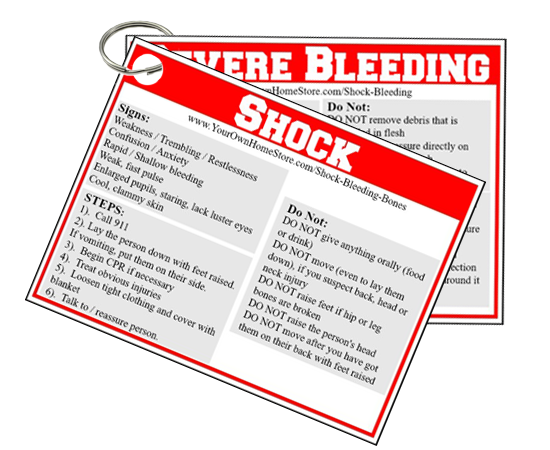With four young kids (including twin boys), I’m sure that odds are good that I will be dealing with a bleeding emergency at some point.
My only hope is that I don’t go into shock as a result!
I want to be able to be prepared in case a bleeding emergency is present. Even if help is on the way, knowing how to handle the situation can make a big difference on the outcome.
And then there is the fact that the bleeding can be due to a local emergency like a hurricane or tornado. In those circumstances, aid may not even arrive fast enough to help.
Even though it scares me, I want to be able to care for my own if I need to! I spent some time studying up on how to do basic first aid for shocks and bleeding and am share what I learned here.
What is shock
Shock is when a person is no longer getting enough blood or oxygen. It often occurs with an injury of some type, but some people go into shock when they see trauma to others as well.
If shock is ignored or untreated, permanent organ damage or death can result.
Signs of shock
Signs of someone being in shock include total body weakness, trembling and / or restlessness.
When someone is in shock they may appear confused and stare with “lack luster” eyes. Their breathing will be rapid and shallow and their pulse rapid and faint.
Their pupils may be enlarged and their skin will likely be pale, cool and clammy.
Treating shock
When treating shock, there are things you should do and things you should not do.
Below are some steps you should do:
- You should call 911 if possible.
- If you do not suspect head, neck or back injuries, lie the person down on their back.
- If you do not suspect hip or leg injuries, raise their feet 8-12 inches above their head.
- If they need CPR, perform it.
- If they have other obvious, serious injuries, treat them.
- Keep them warm and comfortable by loosening tight clothing and covering with a blanket.
- Talk to them and reassure them they will be OK.
- Encourage them to breath slowly and deeply.
- If they vomit, turn them on their side to keep them from choking.
Below are some things you should never do:
- You should not raise their head or give them anything to eat or drink at all.
- Do not move them at all if you suspect head, neck or back injuries.
- Do not raise their feet if you suspect a hip or leg injury.
- You should also avoid moving them once you’ve got them as comfortable as possible until they recover from the shock.
You can find more info on shock and how to treat it from:
Severe Bleeding
Severe bleeding can be scary!
I remember a time when I was babysitting my siblings. I must have been 13 years old or so.
My youngest brother climbed up to the storage unit my Dad had built in the garage. It occupied the space from the ceiling to the garage door (when opened).
I heard screaming outside and ran out to discover that he had jammed his finger in the moving garage door. He was bleeding all over the place. I had taken a babysitting first aid class, but I was freaked out!
It took me a few seconds to gain my composure, grab a cloth and run up to him. It was scary and it was just his finger!
Treatment for bleeding
Below are some basic guidelines for handling a bleeding situation.
- Put on sterile gloves if available.
- Clean out any large or loose debris from the wound – we are not cleaning it yet, just removing big pieces
- Use the palm of your hand (not your fingers) to apply pressure to the wound with a clean cloth or sterile bandage. Sanitary napkins can work very well for this.
- If bleeding is severe, use quikclot. Be aware that quikclot should only be used in true cases of severe bleeding as it is very difficult to remove later.
- If there is debris you had to leave in the wound, do not press directly on it. Instead press as close to the wound as possible without putting pressure on the debris.
- Keep pressure on wound by binding (wrapping in the opposite way of the cut, so the cut is held closed) it with a another bandage or clean cloth. Do not remove the first cloth or bandage. If there is debris still in the wound, wrap around the debris closing the wound as much as possible.
- Have the injured person lie down and raise their injured body part above their heart.
- If blood seeps through bandage, DO NOT remove it to add another. Simply add another on top of the first and continue applying pressuring and bind again.
- Immobilize the injured, bleeding body part.
- If bleeding won’t stop, there is debris you can’t remove, the edges are jagged and very open, the wound shows signs of infection or red streaks around it, or you suspect internal bleeding, seek medical attention ASAP. If 911 isn’t responding, find a doctor as soon as possible.
- Once bleeding has stopped, clean the wound gently with soap and water. Make sure you rinse all the soap out before dressing.
- Apply antibiotic cream and cover with a sterile bandage.
- Change dressing at least daily.
You can find additional on how to handle bleeding below:
- Severe bleeding treatment from the Mayo Clinic
- Treating severe bleeding from WebMD
- Stopping bleeding from Healthline
Free Printables
I have taken many first classes over the years.
But I’m still afraid that when (and if) the time comes, I will be frazzled and might forget something essential. This is why I am a big fan of printables.
A while back, I made a printable first aid quick guide for myself and babysitters that has been helpful. But having something a bit smaller is great as well.
For this post I actually decided to make printable 3×5 cards. These are perfect to laminate as well and them attach to a key ring or throw in a glove compartment.
I will also keep one hanging in the pantry and place one in our 72 hour kits / go-bags.
Please be sure to download a copy for your self as well!
Simply click HERE or on the image below to download them:
You can find additional printables here:
Disclaimer:
I am not a doctor. My advice is simply what I have found from my own research and education.
Please read the information I have linked to for more expert sources and take a first aid / CPR course for complete training.
References:
Becky is a wildlife enthusiast and pet and livestock care expert with a diploma in canine nutrition. With over a decade of experience in animal welfare, Becky lends her expertise to Simple Family Preparedness through insightful info about pets, livestock, bee keeping, and the practicalities of homesteading.




Thank you so much for this great guide. Many parents can benefit from this as many parents have real fears about shock and bleeding emergencies. I agree that even though you may be certified in First Aid or even CPR, in the moment of crisis it is easy to get frazzled and forget what to do. I love the idea of having small notecards in easy to reach spots in case an emergency arises. Thank you so much for sharing this information with your readers.
For more information about basic First Aid, look here: https://chesapeakeaedservices.com/medical-emergency-first-aid-training/
THanks Jon!
These are awesome thanks! because you gave me permission for your other printable I did another post linking to your blog! Thank you so much! https://luvtobabysit.blogspot.com/2016/08/helpful-cards.html
I forgot to say that having raised 3 sons and being accident prone when I was young, I have dealt with lots of cuts, stitches, etc… One evening while I was shopping and my hubby was at home with the boys, I came home to an empty house and all of the lights on. (no cell phones back then). I turned off the lights and started putting up the groceries. My mom-in-law came over and wanted to know why I was still at home, I look at her and said “where do you think I should be?” She said the hospital. Long story short my youngest son was playing on his bunk bed and hit the edge of the bed, blood was everywhere! He had to have stitches right between the eyes!
Scary! I have twin boys so I’m sure I will face a few similar situations (except gratefully, I will have a cell phone!)
I have twin granddaughters and one broke her arm just above the elbow, it had to have screws in it for a while. The other one had a hole in her heart, she had surgery not long after the broken arm incident. They are both fine now but boy what a year!
OH my yes! That is quite a year! Glad to know they are both okay.
Ground red pepper also works well to stop bleeding. Just sprinkle liberally over an open wound. It will burn at first but it will stop the bleeding.
Thanks Brenda!
Just wondering how to get the hypothermia printables? It gives the shock and cpr handout. Thanks for sharing and helping the rest of us.
Liz
Misty,
Your links to the printables are messed up. I got shock and severe bleeding, but the other 4 don’t show up. The CPR states no page and the Heat Stroke goes back to the Shock one.
I love this course.
Thank you,
Teresa
Thanks Teresa! sometimes I just can’t keep it all strait. I will go check them out.
Thanks for the Printables. I love them.
You are so welcome Ruth!